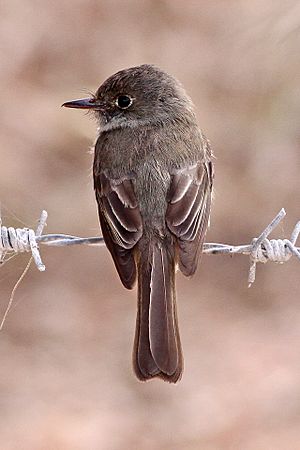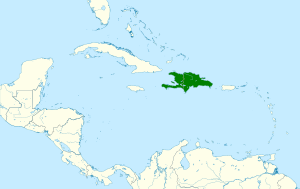Hispaniolan pewee facts for kids
Quick facts for kids Hispaniolan pewee |
|
|---|---|
 |
|
| In Sierra de Bahoruco National Park | |
| Conservation status | |
| Scientific classification | |
| Genus: |
Contopus
|
| Species: |
hispaniolensis
|
 |
|
The Hispaniolan pewee (Contopus hispaniolensis) is a small bird. It belongs to the Tyrannidae family, also known as flycatchers. This bird is special because it lives only on the island of Hispaniola. Hispaniola is split into two countries: the Dominican Republic and Haiti.
Contents
About the Hispaniolan Pewee
The Hispaniolan pewee is a type of passerine bird. This means it is a perching bird. It was first described in 1867 by Henry Bryant. Like other pewees, it is known for its simple, clear calls. These calls often sound like "pee-wee."
What Does It Look Like?
The Hispaniolan pewee is a small bird. It usually measures about 14 to 16 centimeters (5.5 to 6.3 inches) long. Its feathers are mostly dull gray or olive-brown. It has a lighter belly. Its wings and tail are a bit darker. These colors help it blend in with the trees. This makes it hard for predators to spot.
Where Does It Live?
This bird lives in many different habitats across Hispaniola. You can find it in forests, woodlands, and even coffee plantations. It prefers areas with tall trees. These trees provide good spots for perching and hunting. It lives in both dry and moist forests. It can be found from sea level up to high mountains.
What Does It Eat?
The Hispaniolan pewee is an insectivore. This means it eats insects. It is a skilled hunter. It often perches on a branch. From there, it watches for flying insects. When it sees one, it quickly flies out to catch it in mid-air. Then it returns to its perch. Its diet includes flies, beetles, and other small bugs. This helps control insect populations.
How It Behaves
Hispaniolan pewees are generally shy birds. They are often seen alone or in pairs. They are most active during the day. Their calls are a key way to identify them. They use their calls to communicate with other birds. They also use them to mark their territory.
Life Cycle and Reproduction
Like most birds, the Hispaniolan pewee builds a nest. The nest is usually cup-shaped. It is made from plant fibers and spider webs. It is often placed high up in a tree. The female bird lays a few eggs. Both parents help to care for the young. They feed the chicks insects until they are old enough to fly. The exact breeding season can vary. It often happens during the warmer, wetter months.
Protecting This Bird
The Hispaniolan pewee is currently listed as "Least Concern" by the International Union for Conservation of Nature (IUCN). This means it is not considered to be in immediate danger. However, its habitat is still threatened. Deforestation and habitat loss are big problems on Hispaniola. Protecting the forests where it lives is important. This helps ensure the pewee has a safe place to live.
See also
 In Spanish: Pibí de La Española para niños
In Spanish: Pibí de La Española para niños


